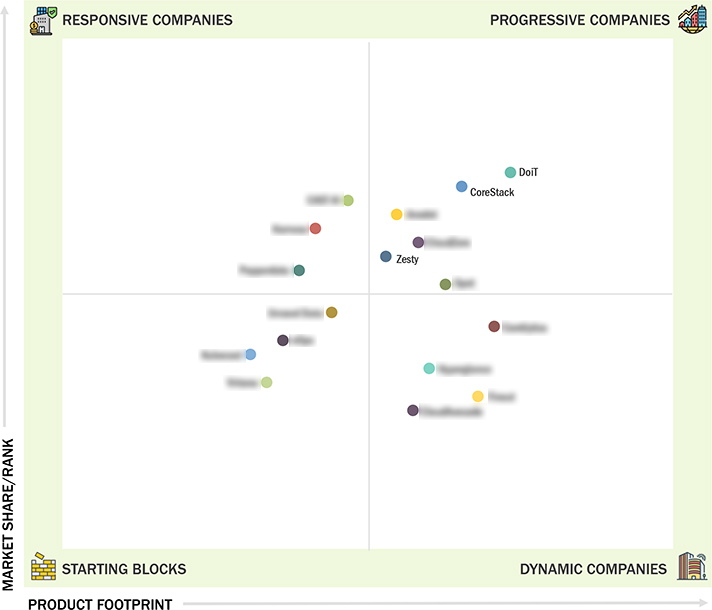Comparing 17 vendors in Cloud FinOps Startups across 0 criteria.
Cloud FinOps as a set of practices and tools designed to manage, optimize, and govern financial expenditures in cloud computing environments. It involves a combination of financial management, cost optimization, and operational practices to maximize the business value of cloud spending. Cloud FinOps aims to provide organizations with visibility, accountability, and control over their cloud costs, enabling them to optimize cloud resource usage, manage budgets, and implement cost-saving strategies effectively. According to the FinOps Foundation, “FinOps is an operational framework and cultural practice which maximizes the business value of cloud, enables timely data-driven decision making, and creates financial accountability through collaboration between engineering, finance, and business teams.
Market Leadership Quadrant
1.1 Study Objectives
1.2 Market Definition
1.2.1 Inclusions and Exclusions
1.3 Study Scope
1.3.1 Market Segmentation
1.4 Years Considered
1.5 Currency Considered
1.6 Stakeholders
1.7 Recession Impact
2.1 Introduction
2.2 Market Dynamics
2.2.1 Drivers
2.2.1.1 Abundance of Cloud FinOps jobs availability
2.2.1.2 Cloud FinOps enhances data visibility for accountability
and optimization
2.2.1.3 Integrating Cloud FinOps team into existing organizational
structure
2.2.1.4 Cloud FinOps culture significantly improves investment
value realization
2.2.2 Restraints
2.2.2.1 Unnecessary cloud expenses (cloud waste)
2.2.2.2 Resistance to switch to Cloud FinOps solutions
2.2.3 Opportunities
2.2.3.1 Leveraging automation tools to streamline FinOps
implementation
2.2.3.2 Growing awareness of cloud cost governance creates
opportunities for Cloud FinOps growth to scale
2.2.3.3 Opportunity to maximize Cloud ROI using Cloud FinOps
strategies
2.2.4 Challenges
2.2.4.1 Effective management of relationships and negotiations with
several cloud service providers
2.2.4.2 Implementation of suggested changes hinders evolving Cloud
FinOps space
2.3 Ecosystem
2.4 Supply Chain Analysis
2.4.1 Cloud Service Providers
2.4.2 Cloud Finops Platforms and Tools
2.4.3 Managed Service Providers and Consulting Firms
2.4.4 Enterprise it and Finance Departments
2.4.5 Software and Solution Integrators
2.4.6 Regulatory and Compliance Bodies
2.5 Technology Analysis
2.5.1 Key Technologies
2.5.1.1 Resource tagging
2.5.1.2 Automated resource provisioning
2.5.1.3 Instance reservation systems
2.5.2 Complementary Technologies
2.5.2.1 Auto scaling
2.5.2.2 Instance rightsizing
2.5.2.3 Containerization
2.5.2.4 DevOps
2.5.3 Adjacent Technologies
2.5.3.1 Serverless computing
2.5.3.2 Predictive analytics
2.5.3.3 Automation
2.6 Cloud Finops Market: Business Models
2.6.1 Consulting Services
2.6.2 Software Tools
2.6.3 Training & Education
2.6.4 Managed Services
2.6.5 Cost Optimization Strategies
2.6.6 Partnerships & Integrations
2.6.7 Subscription-Based Pricing
2.7 Patent Analysis
2.8 Porter’s Five Forces Analysis
2.8.1 Threat of New Entrants
2.8.2 Threat of Substitutes
2.8.3 Bargaining Power of Buyers
2.8.4 Bargaining Power of Suppliers
2.8.5 Intensity of Competitive Rivalry
2.9 Cloud Finops Market: Key Conferences and Events, 2024–2025
2.10 Trends and Disruptions Impacting Customers’ Businesses
2.11 Key Stakeholders and Buying Criteria
2.11.1 Key Stakeholders in Buying Process
2.11.2 Buying Criteria
2.12 Investment Landscape
3.1 Introduction
3.2 Key Player Strategies/Right to Win
3.3 Market Share Analysis
3.4 Cloud Finops Market: Vendor Products/Brands Comparison
3.5 Revenue Analysis
3.6 Company Evaluation Matrix: Startups/SMEs, 2023
3.6.1 Progressive Companies
3.6.2 Responsive Companies
3.6.3 Dynamic Companies
3.6.4 Starting Blocks
3.6.5 Competitive Benchmarking: Startups/SMEs, 2023
3.6.5.1 Detailed list of key startups/SMEs
3.6.5.2 Competitive benchmarking of key startups/SMEs
3.7 Company Valuation and Financial Metrics of Key Vendors
3.8 Competitive Scenario and Trends
3.8.1 Product Launches
3.8.2 Deals
4.1 DOIT
4.1.1 Business overview
4.1.2 Products/Solutions/Services offered
4.1.3 Recent developments
4.2 CORESTACK
4.2.1 Business overview
4.2.2 Products/Solutions/Services offered
4.2.3 Recent developments
4.3 ANODOT
4.3.1 Business overview
4.3.2 Products/Solutions/Services offered
4.3.3 Recent developments
4.4 CLOUDZERO
4.4.1 Business overview
4.4.2 Products/Solutions/Services offered
4.4.3 Recent developments
4.5 SPOT
4.5.1 Business overview
4.5.2 Products/Solutions/Services offered
4.5.3 Recent developments
4.6 CAST AI
4.6.1 Business overview
4.6.2 Products/Solutions/Services offered
4.6.3 Recent developments
4.7 HARNESS
4.7.1 Business overview
4.7.2 Products/Solutions/Services offered
4.7.3 Recent developments
4.8 ZESTY
4.8.1 Business overview
4.8.2 Products/Solutions/Services offered
4.8.3 Recent developments
4.9 PEPPERDATA
4.9.1 Business overview
4.9.2 Products/Solutions/Services offered
4.9.3 Recent developments
4.10 CENTILYTICS
4.10.1 Business overview
4.10.2 Products/Solutions/Services offered
4.10.3 Recent developments
4.11 HYPERGLANCE
4.11.1 Business overview
4.11.2 Products/Solutions/Services offered
4.11.3 Recent developments
4.12 FINOUT
4.12.1 Business overview
4.12.2 Products/Solutions/Services offered
4.12.3 Recent developments
4.13 CLOUDAVOCADO
4.13.1 Business overview
4.13.2 Products/Solutions/Services offered
4.13.3 Recent developments
4.14 UNRAVEL DATA
4.14.1 Business overview
4.14.2 Products/Solutions/Services offered
4.14.3 Recent developments
4.15 NOPS
4.15.1 Business overview
4.15.2 Products/Solutions/Services offered
4.15.3 Recent developments
4.16 KUBECOST
4.16.1 Business overview
4.16.2 Products/Solutions/Services offered
4.16.3 Recent developments
4.17 VIRTANA
4.17.1 Business overview
4.17.2 Products/Solutions/Services offered
4.17.3 Recent developments


 Finovate
Finovate
 Nov 2025
Nov 2025

